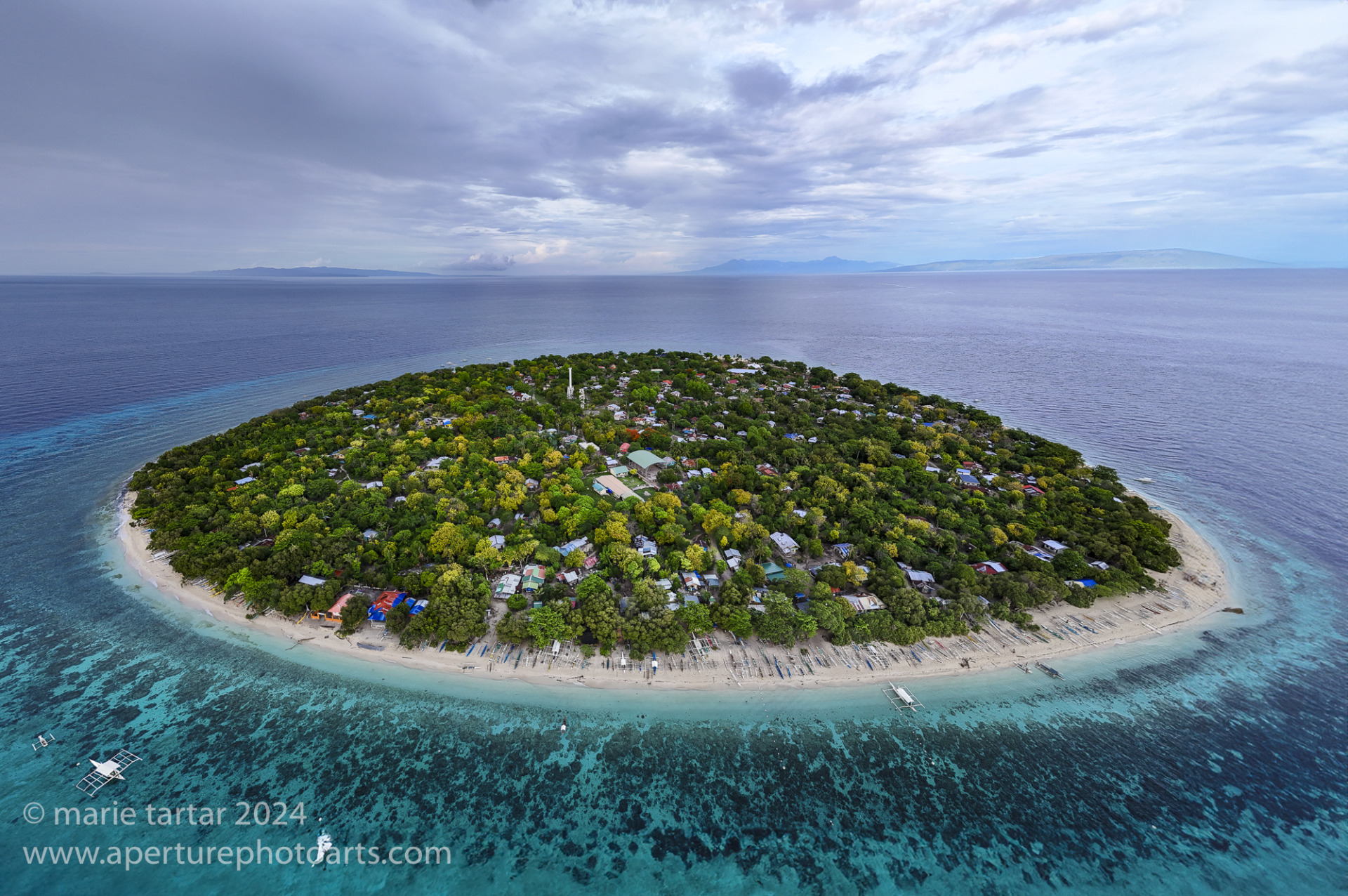
All too soon, we were at the halfway point of our long awaited 10-day voyage on the Atlantis Azores. Our 5 days at remote Tubbataha did not disappoint.
Friday June 28, 2024
(Cagayancillo Island)
Land ho: after 5 days in Tubbatha, we dived near Caganyancillo Island.
Greg tested negative finally, waving around his Covid test card like a proud kid with a lollipop.
We steamed overnight away from Tubbataha and towards the Visayas, arriving in time to do two morning dives at Cagayancillo Island:
Dive 1 (63 min 69 ft): Nonoy Point
Dive 2 (65 min 63 ft): Subway
We could now see land, a verdant vegetation covered island. The water was so clear we could peer over the side of the skiff and easily see the reef below, the drop-off and pyramid butterfly fish fluttering along the rim.
The stunning light, fans, corals, whip corals, barrel sponges and profusion of colorful fish everywhere added up to a dive that makes one glad to be alive to see such breath-taking beauty.

The profusion of fish and health of the fans and corals at Cagayancillo Island was fabulous! (Visayas, Philippines)

A spectacular soft coral bouquet protrudes from the reef wall at Cagayancillo Island, Visayas, Philippines.
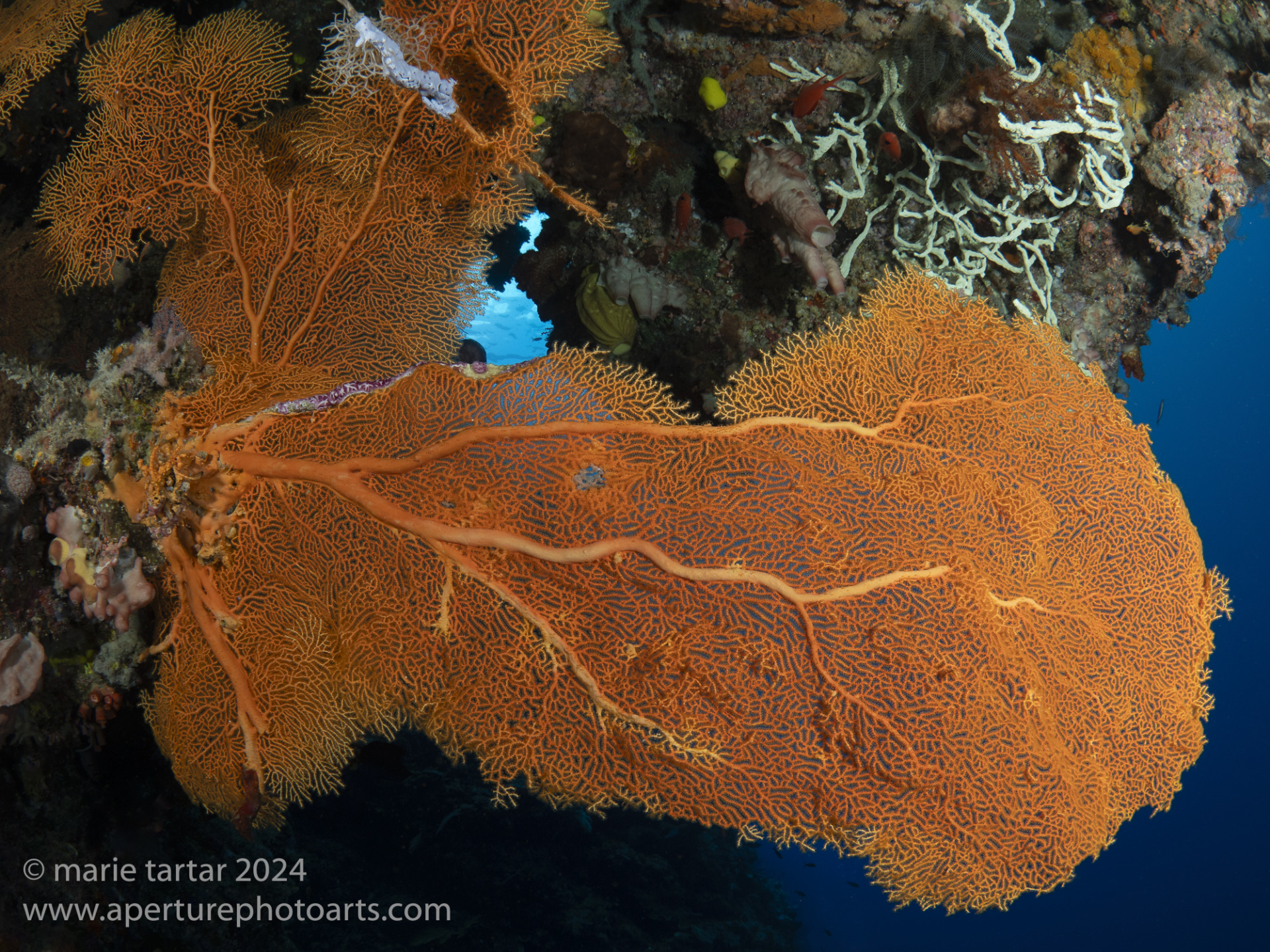
Huge golden sea fans anchor a particularly picturesque passage with craggy outcrops and passageways near Cagayancillo Island, Visayas, Philippines.

An underwater bouquet of soft corals and a golden crinoid in the Visayas (Cagayancillo Island), Philippines
I flew the drone after breakfast between dives; it is VERY tricky catching it with the boat moving.
Saturday, June 29, 2024
Siquijor Island
During the long crossing the prior day, I switched my camera system over to shoot macro. There was a strong current on entry, which dissipated once over the edge along the wall.
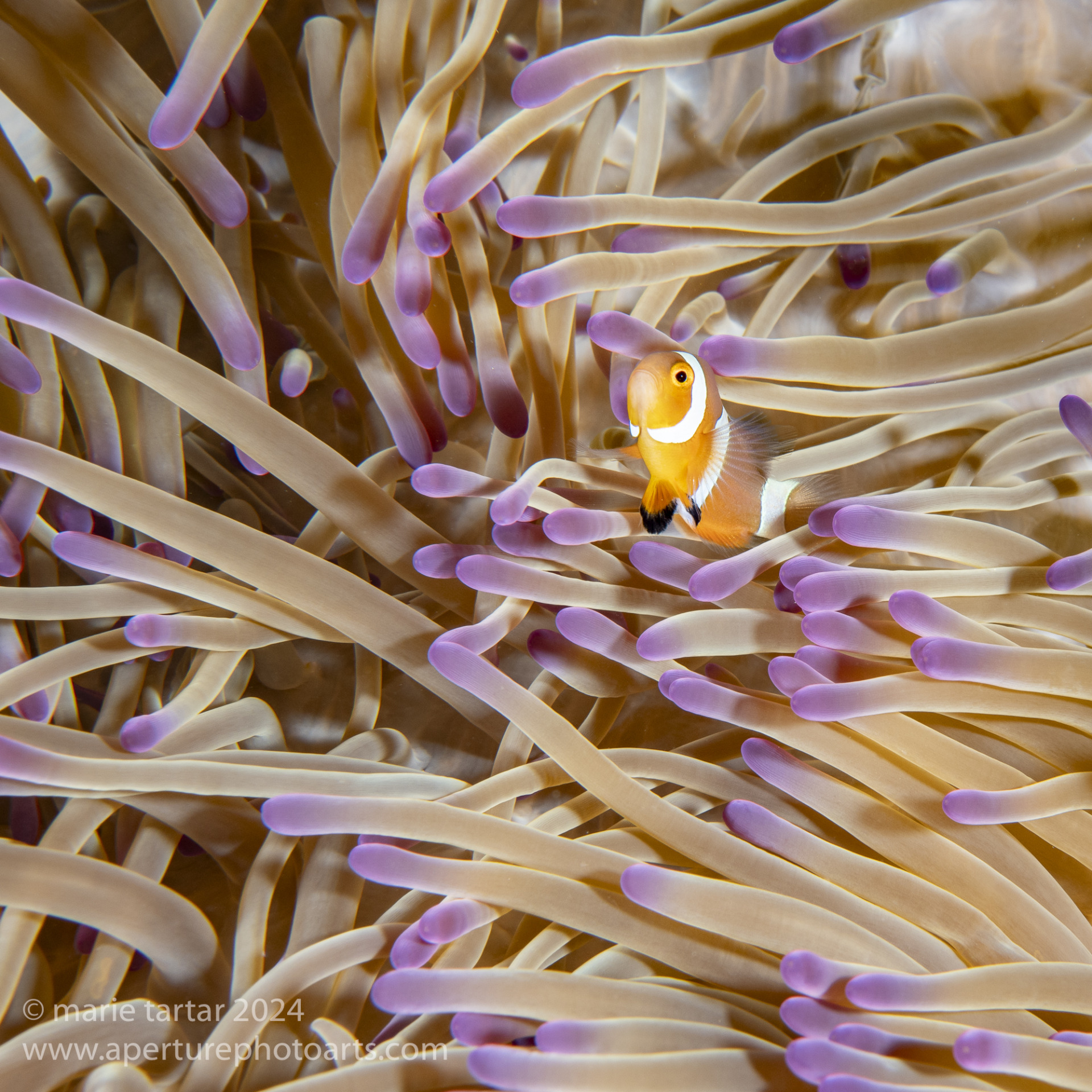
Endless combinations of colorful anemones and lively anemonefish in the Philippines (Siquijor Island, Visayas).
Both of our morning dives were at Paliton Wall (68 min 52 ft and 67 min 63 ft).
Norway showed me a series of subjects: a pair of bubble coral shrimp, a tiny black and white nudibranch, and a major find by Aries, a sizable pale frogfish sheltered beneath a matching sponge.

Pretty in pink and great find by Aries: frogfish on a wall under a matching sponge (Siquijor Island, Visayas, Philippines).
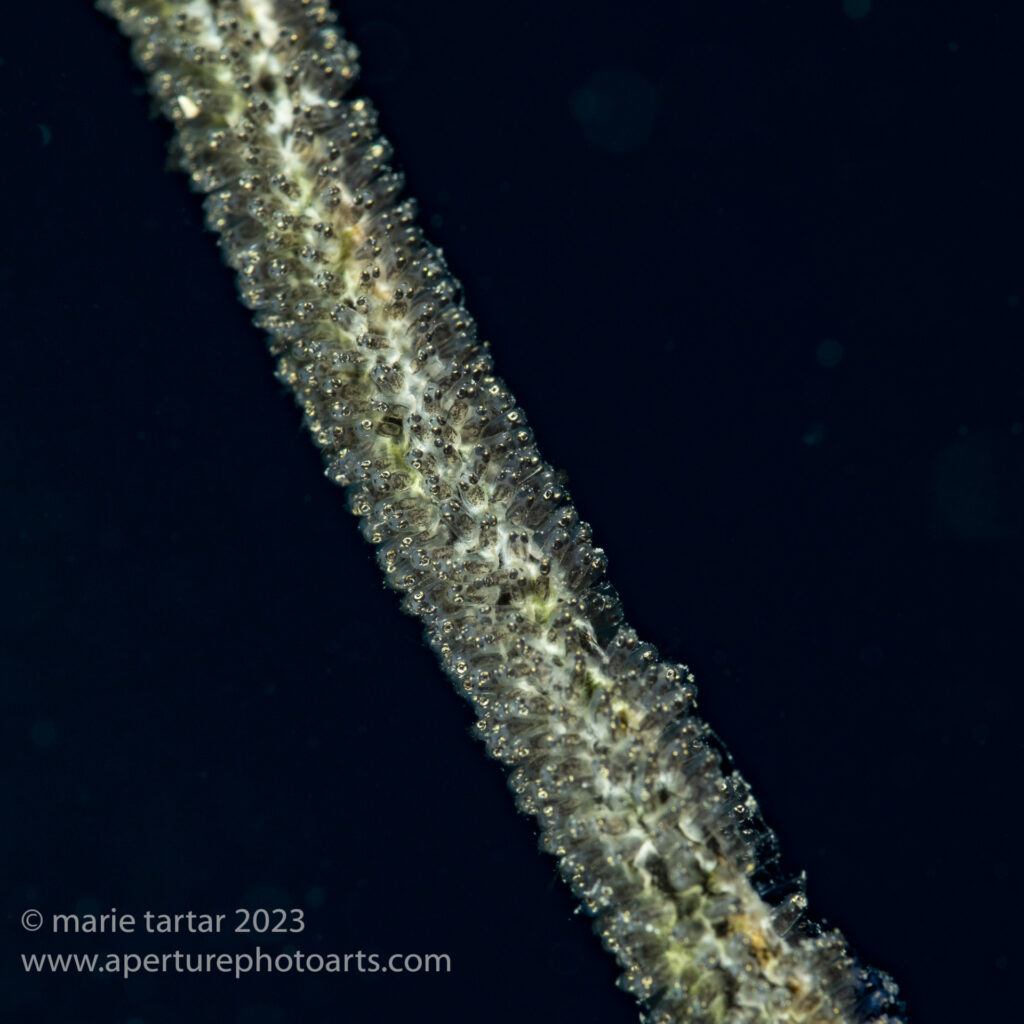
Norway showed me this: damselfish eggs deposited on a supporting stalk (Siquijor Island, Visayas, Philippines).
On our 3rd dive, at Maeti Wall (64 min 65 ft), the visibility was dropping. We ended up in 2 groups (me, Greg and Steve with Norway).
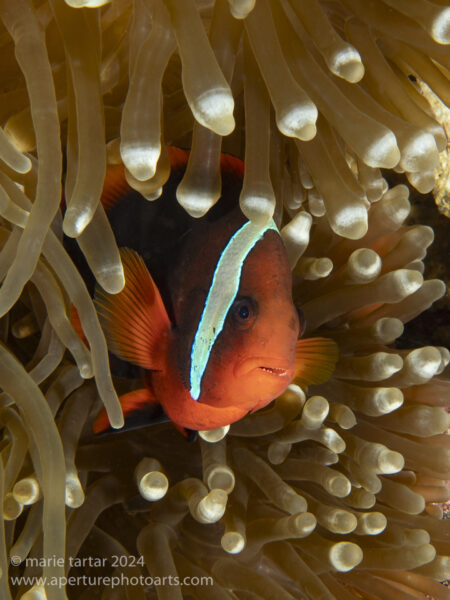
Yes, I do still brake for any halfway cooperative anemonefish in an attractive anemone and bubble-tip is one of my favorites! (Siquijor Island, Visayas, Philippines)

This bubble-tip anemone and anemonefish have built-in shelter in the form of hard coral. (Siquijor Island, Visayas, Philippines)
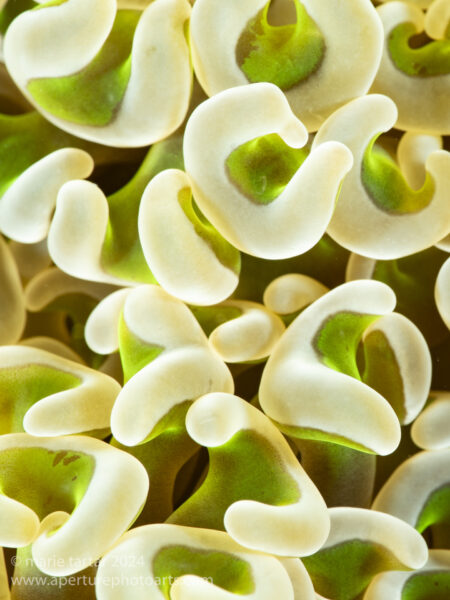
I suspect Mike B’s video on patterns inspired this composition. (Siquijor Island, Visayas, Philippines)
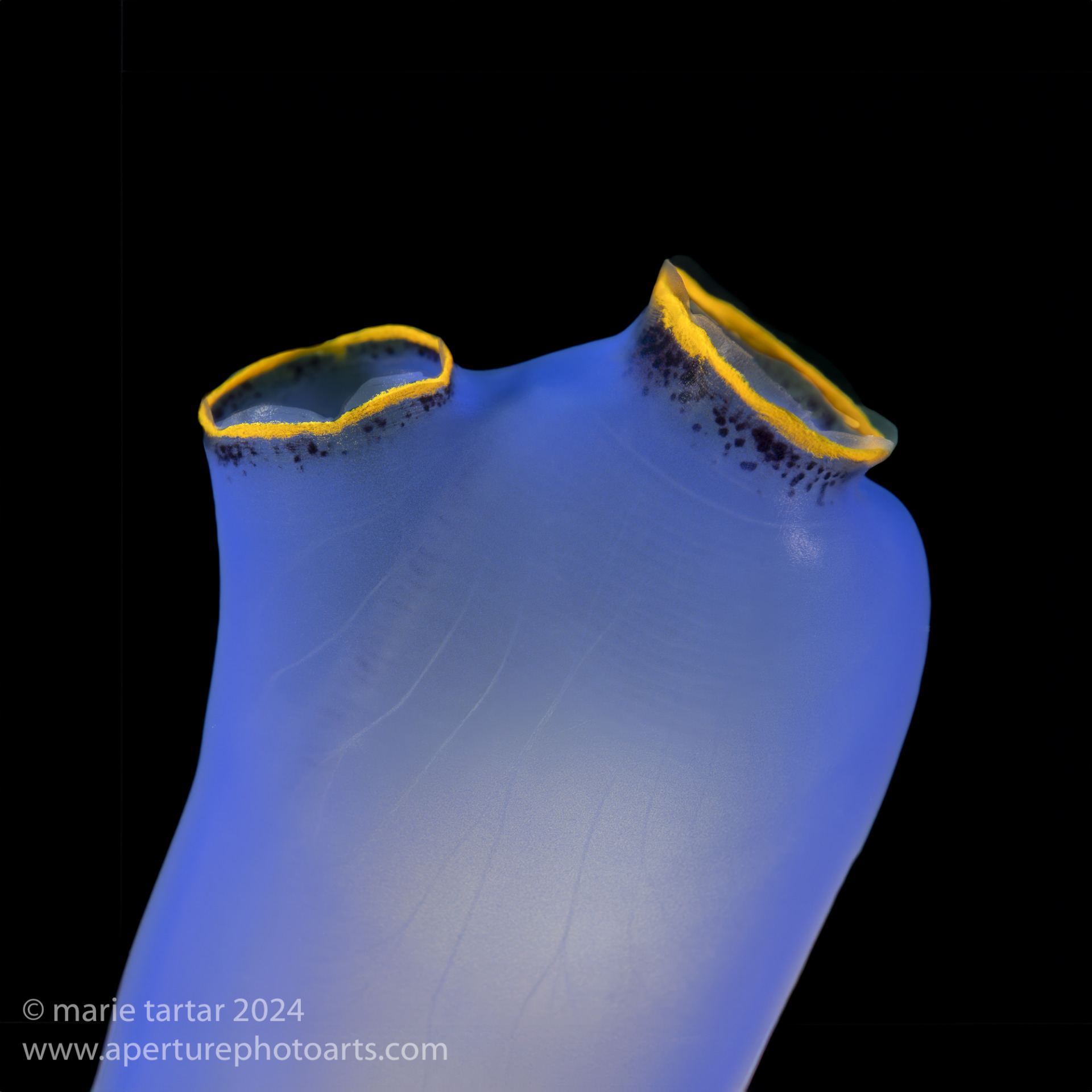
A solitary tunicate brings to mind for me Dale Chihuly’s baskets or soft cylinders. (Siquijor Island, Visayas, Philippines)

Star puffer (Arothron stellatus) sporting a bluestreak cleaner wrasse (Labroides dimidiatus) like a jaunty striped cap. (Siquijor Island, Visayas, Philippines)
Norway showed me a great but elusive subject, a black and white crinoid shrimp, deeply concealed by a matching crinoid, which folded its arms protectively over the small shrimp.
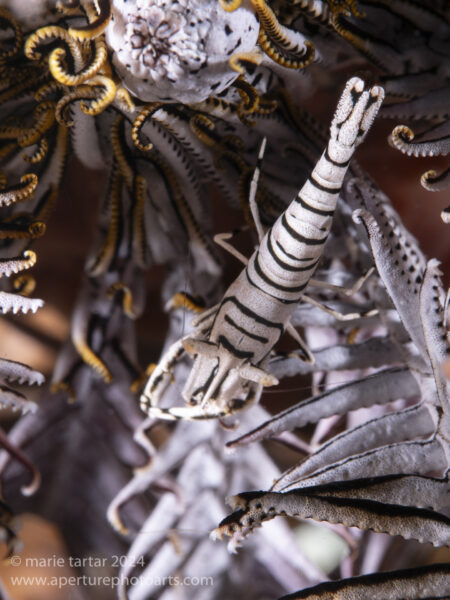
So frustrating when you know there is a crinoid shrimp inside a crinoid (perfectly matched) and the crinoid goes on the defensive! (Siquijor Island, Visayas, Philippines)
I flew the drone after the 3rd dive, after deciding to forego a 4th dive, also to Maeti Wall. It was quite a tense adventure catching the drone on the moving boat; the captain helped me at the bow.
A flood below decks, affecting our room and Andrew and Leigh’s across the hall, conjured up mental images of sewage backing up. I put on my SCUBA booties (VERY difficult to don without scuba socks) to creep into our room to fetch my flip-flops lest any of the joking about the source of the flood waters (Greg’s bathroom) was true.
Sunday, June 30, 2024
Oslob and Cebu

This was a fun hour-long dive at Oslob, Cebu for us. The snorkelers had to arise before dawn to avoid hours long waits swim 1/2 hour with the whale sharks.
Our first dive (61 min 32 ft) was mobbed with snorkelers. Tan-awan, Oslob on the southeast corner of Cebu Island, became famous in 2011 for whale shark encounters.
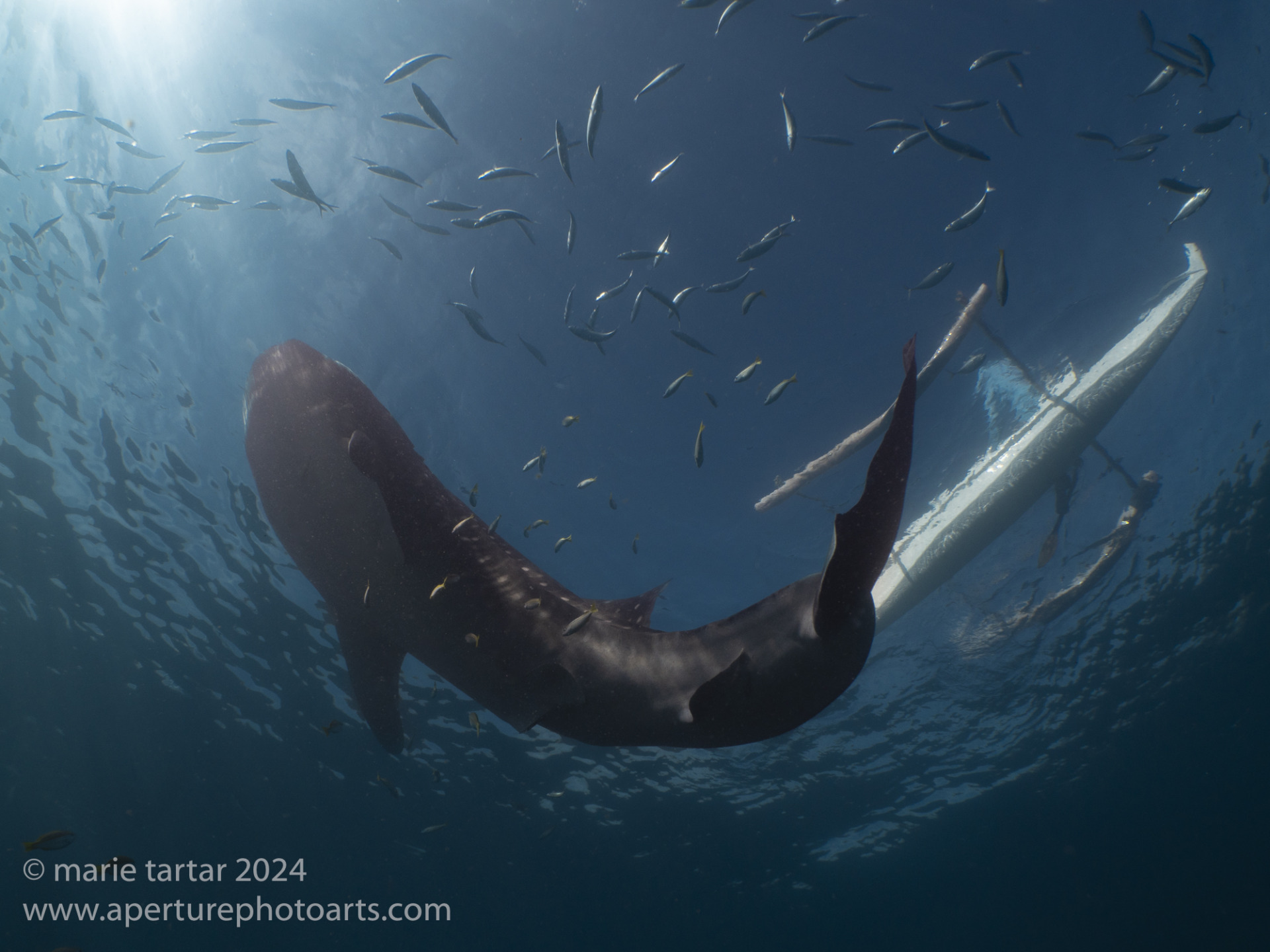
This looks peaceful , but steering around the bubbles, bicycling snorkelers, bobbing boats and watching out for cruising whale sharks and trying to avoid being whacked by their enormous tails, was anything but! Oslob, Cebu, Philippines.
Fisherman in bangka feed the whale sharks shrimp in the mornings. Veritable fleets of bangkas with snorkelers, bicycling frantically, produced a confusion of bubbles, shadows, boats and sun overhead. Perhaps Oslob should be renamed Os-mob.
Greg and I both flew our drones briefly over the crowd afterwards.
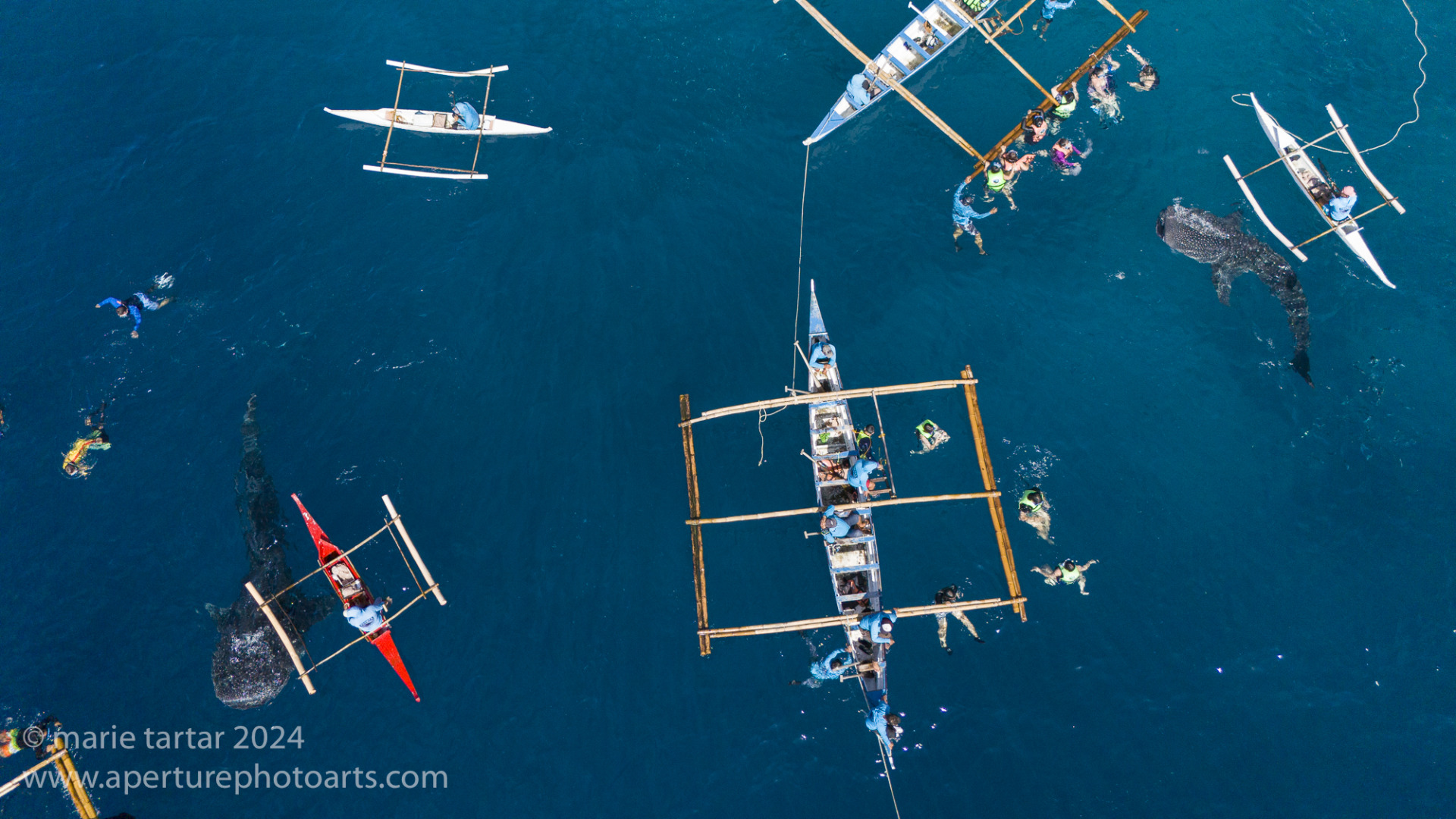
Oslob was mobbed with snorkelers who rose before dawn and waited hours to swim with whale sharks for a half hour. In the blogosphere, this is not without controversy. Arguments are that feeding shrimp to whale sharks is nutritionally deficient and disrupts their natural migration patterns. It certainly was chaotic, with boats and swimmers and whale sharks in motion. Not surprisingly, it’s been observed that the whale sharks sustain many lacerations, presumably from collisions with boats. The snorkelers are not allowed to wear fins. Most didn’t appear all that comfortable in the water or graceful.
On our second dive, to Barracuda Point (68 min 64 ft), I made an interesting (at least to me) discovery. I went down with the WWL-1, which is a wet wide angle lens used with a 14-42 mm lens. At 14 mm, it has a field of view of 135 degrees. I had previously assumed it would be useless with small subjects. Among the islets of reef punctuating a sandy slope, there were many anemones with fish.
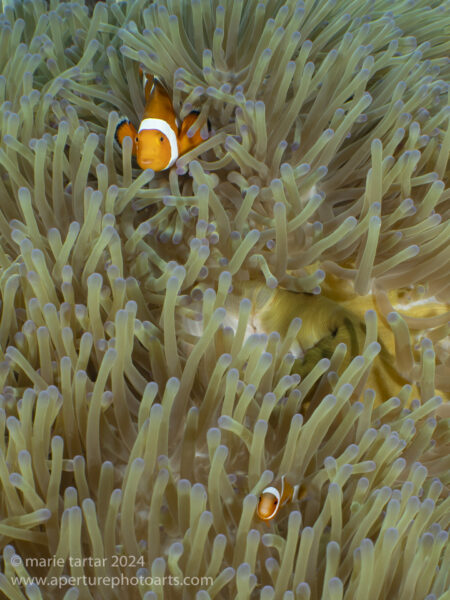
You would think by now I could resist the charms of anemones and anemonefish, but why try? (Barracuda Point, Visayas, Philippines)
A pair of banded pipefish in a crevice and a squat lobster on a barrel sponge shouldn’t have been possible subjects to shoot with my rig, but Steve showed me his results with the pipefish with his wide angle rig and I thought it was worth a try. I was pleasantly surprised at the results.

Photograph a banded pipefish (Dunckerocampus dactyliophorus) with a wdie-angle rig? Who knew? (Barracuda Point, Visayas, Philippines)
We encountered similar terrain on our 3rd dive at Cottage Point (66 min 57 ft). There was such a plethora of anemones and damselfish, I thought this site should be re-christened Anemone City or Damselfish Digs. They are everywhere, loud enough to be heard. A few of the anemones were balled up, revealing the luscious colors of their undersides.
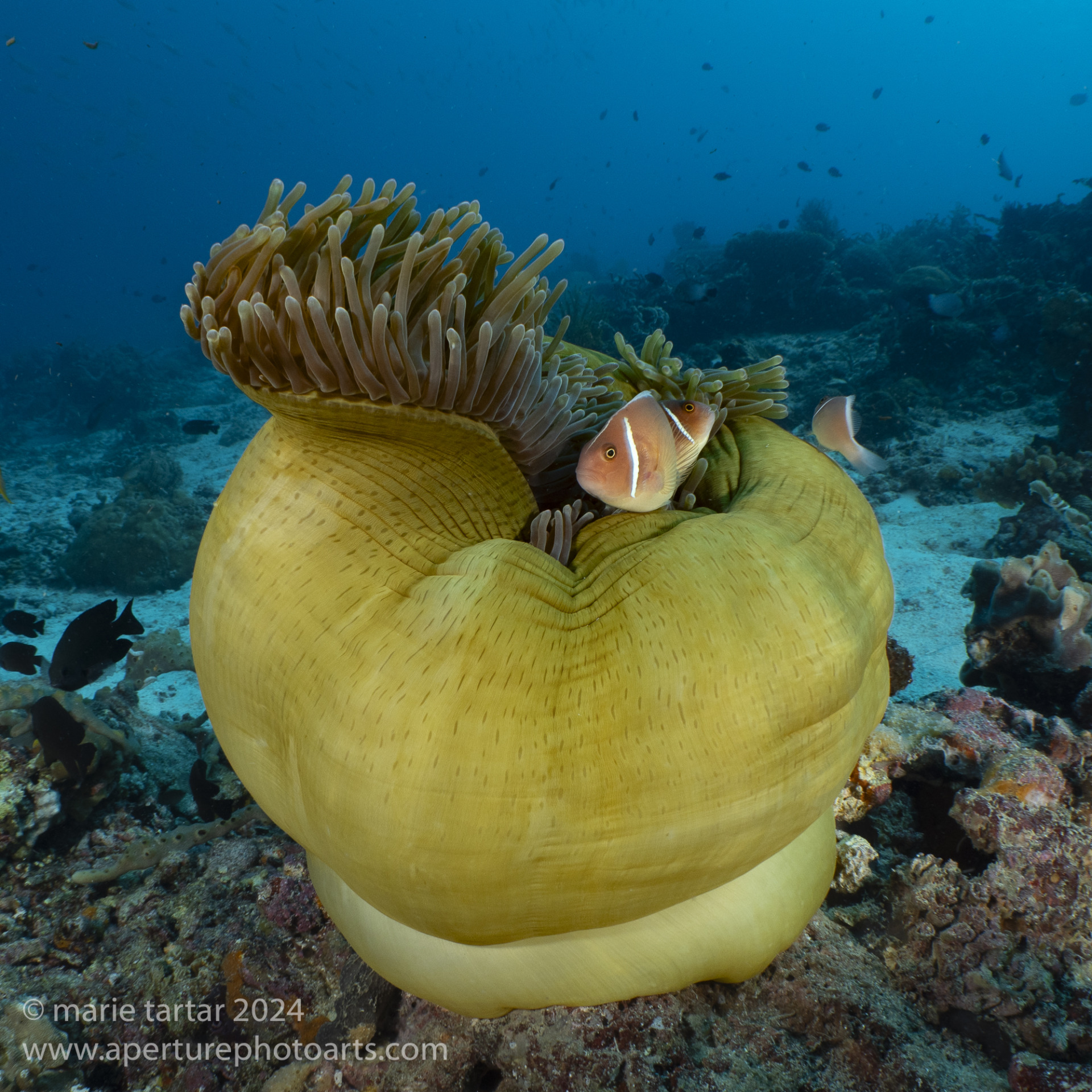
Closing up shop as the light fades in the afternoon: pink skunk anemonefish (Amphiprion perideraion) peer out of their home anemone.
In the blue, the water was shimmering with feeding mackerel, whose open mouths could be clearly seen at work.
Steve, Greg and I ended up alone at the end of the dive (1 hour), so we ascended together, with me holding Greg’s heavy weight of a camera (taking me down 10 feet) while he deftly deployed his SMB.
Steve and I again decided 3 dives were enough for us, as did Lynn. The usual stalwarts, Dan, Mike B, Mike K and Greg, headed off to Guard House for a 4th with Nelson driving the skiff, and dive guides Aries and Norway.
The day was capped by a special BBQ dinner upstairs and an unforgettable performance by the crew (unrecognizable in drag) to the tune of Cindi Lauper’s Girls Just Want to have Fun. I laughed so hard, tears streamed down my face.
Monday July 1, 2024
Balicasag Island
Today was our 35th wedding anniversary!
There was only a smattering of boats when I flew the drone before our first dive before breakfast, but Aries was emphatic that we would soon be invaded. Indeed, as we prepared to roll backwards into the water, a veritable armada could be seen approaching.
Dive 1: At Black Forest (65 min 62 ft), we found a riot of fish, including schooling jacks and feeding long-mouthed mackerel awaited at the reef’s rim.
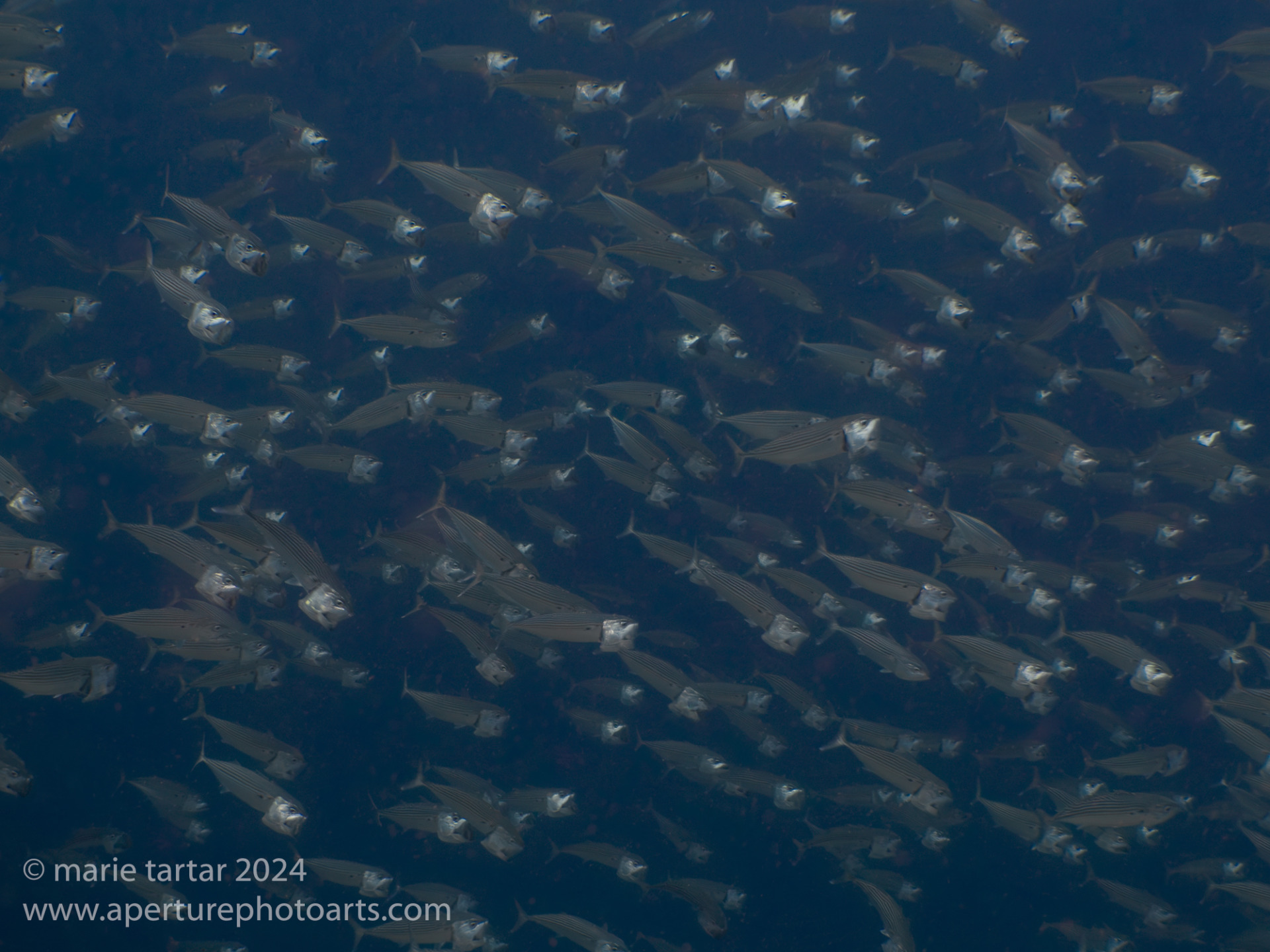
A strange sight, out in the blue, the opening and closing of the mouths of long-mouthed mackerels (Visayas, Philippines).
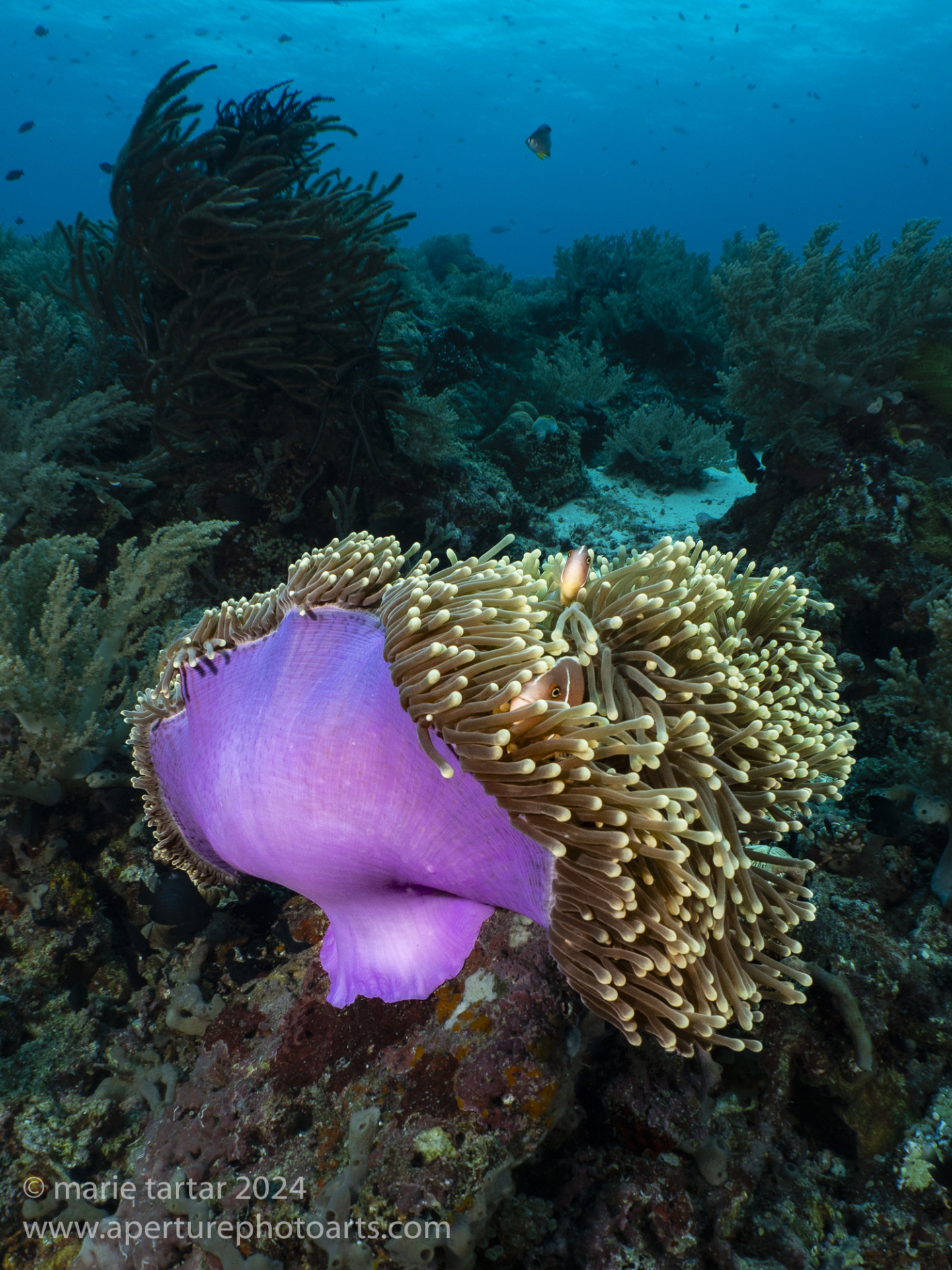
Anemones are even more lovely when they ball up and reveal their undersides (Balicasag, Visayas, Phillipines)
Among the abundant anemones, were the fluorescent orange variety on the sloping reef.

Not all anemonefish are brilliant orange. This large dark anemonefish might be the female of a mating pair. All anemonefish are born male and are hermaphrodites, changing into females as necessary for reproduction. The female mates with the largest male, who will change sex and take her place as a female after her death.
Two turtles fed in the grassy shallows.
Boat traffic could be heard roaring through. Two German snorkelers asked Mike B in the water if he would share his footage.

Yeah, a lot of boat traffic at Balicasag. The water is so clean, one can read the name of the boat from the reef.
Dive 2 (Divers Heaven for 64 min 50 ft).
I missed Mike K’s frogfish find. On the other boat, dive guide Eric found 5 frogfish!
Steve stalked a peacock mantis shrimp at the base of a bommie. A hawksbill turtle fed determinedly.
We survived the dramatic increase in boat traffic, which I documented by drone between dives.
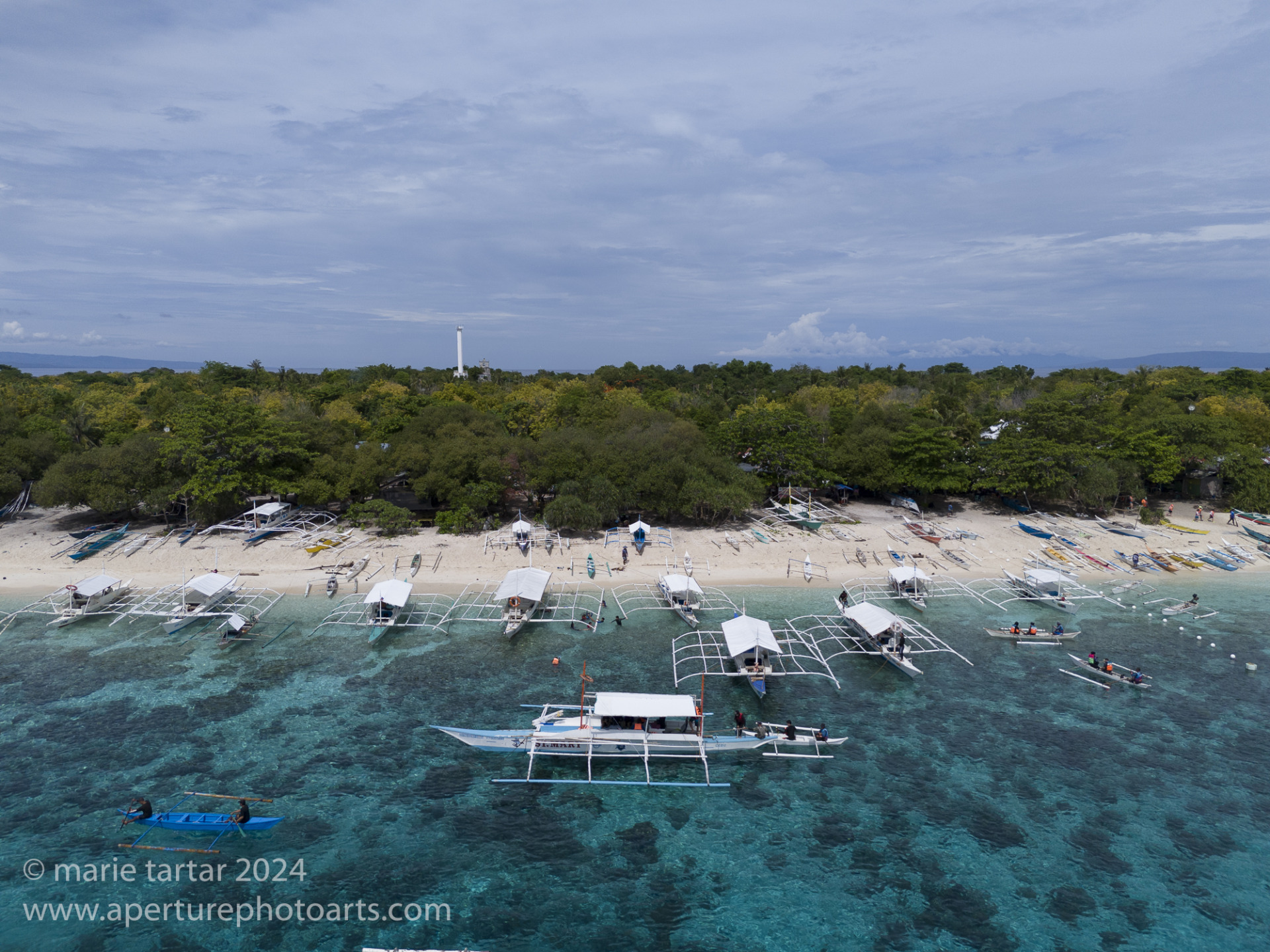
We made it into the water before most of the daytrippers arrived, but there definitely was a lot of boat traffic by the time we exited the water (Balicasag, Visayas, Phiippines).
Dive 3 (Danao Wall, 66 min 47 ft): Kate, Andrew and Leigh knocked off diving, in anticipation of their imminent departures. My squeaky right ear discouraged me from a 4th dive on Alona House Reef. Norway showed me 3 successive small frogfish (a yellow painted, white painted and orange), each more difficult than the next to photograph.
Overall, I did 27 dives on Azores.
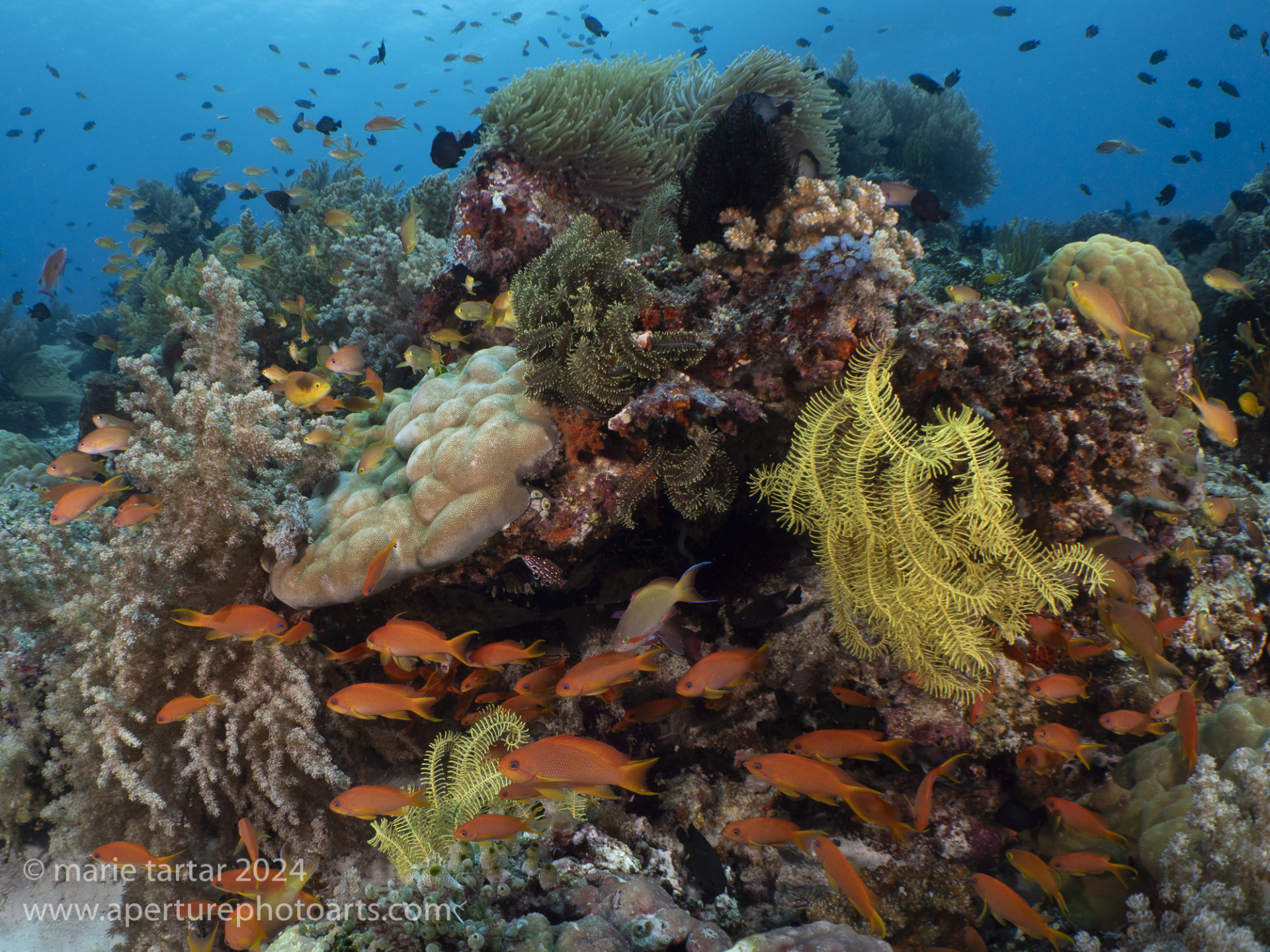
Healthy reefs, swirling with fish, great memories of the crew, the food and the diving on the Atlantis Azores!
The crew surprised Steve and me with a chocolate 35th wedding anniversary cake after dinner, a nice final flourish to a great celebratory voyage!
-Marie
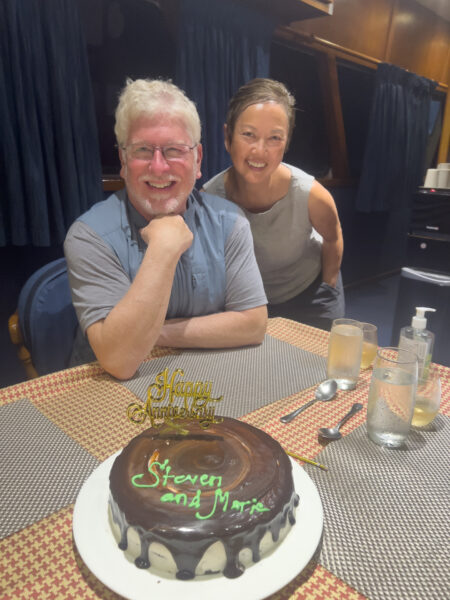
I can’t think of a much better way to mark 35 great years together than on the Atlantis Azores in the Philippines.


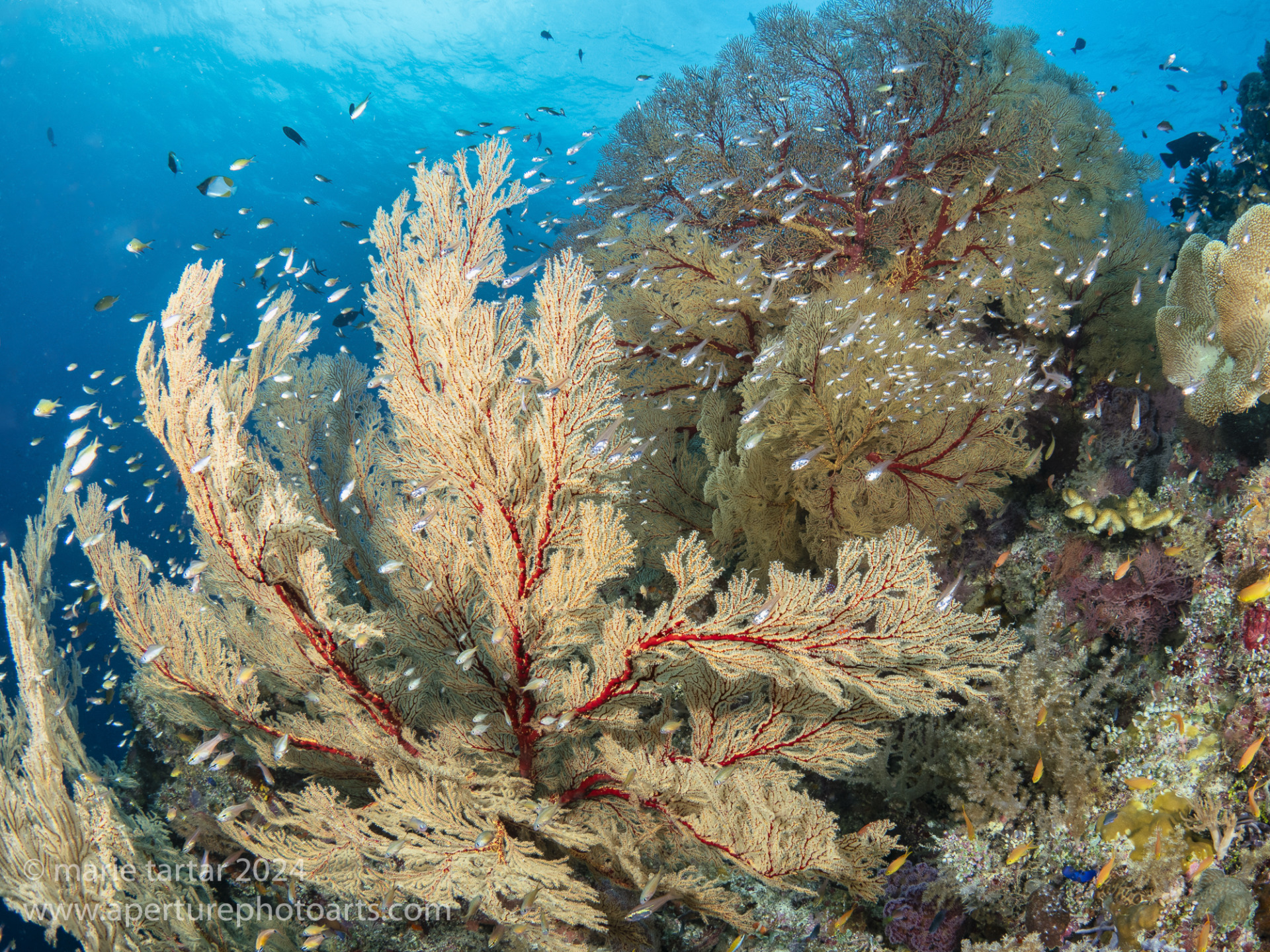
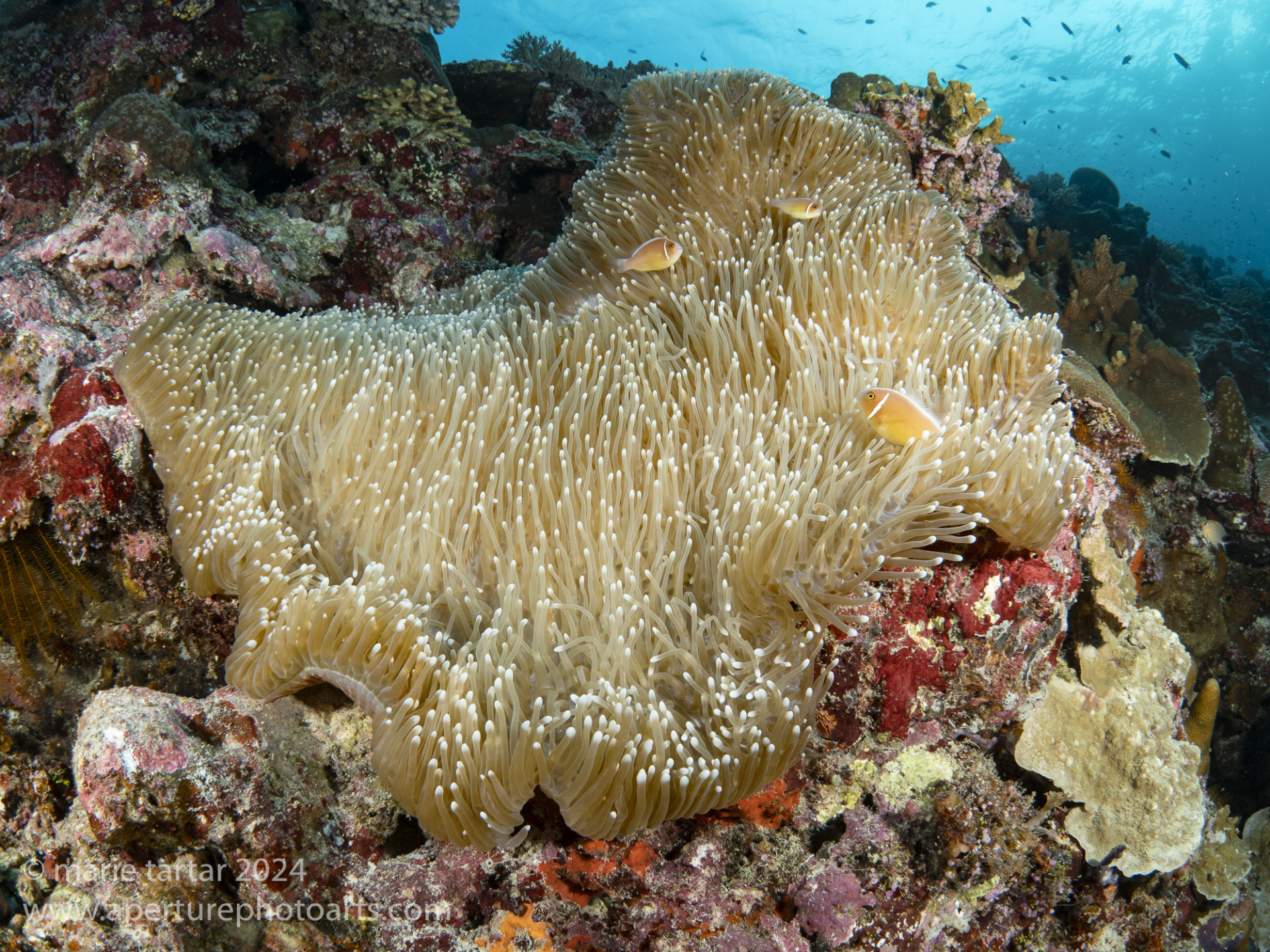
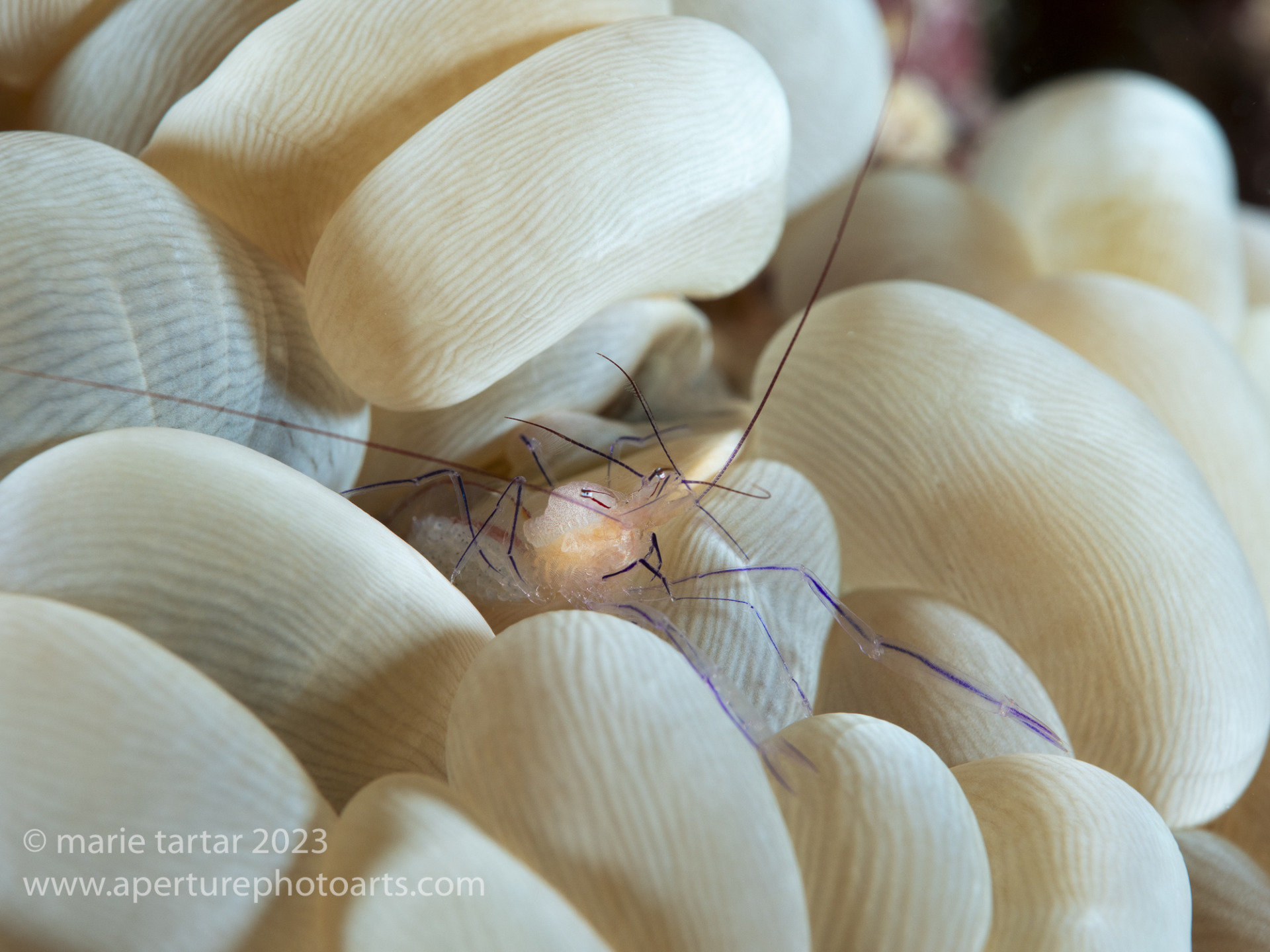

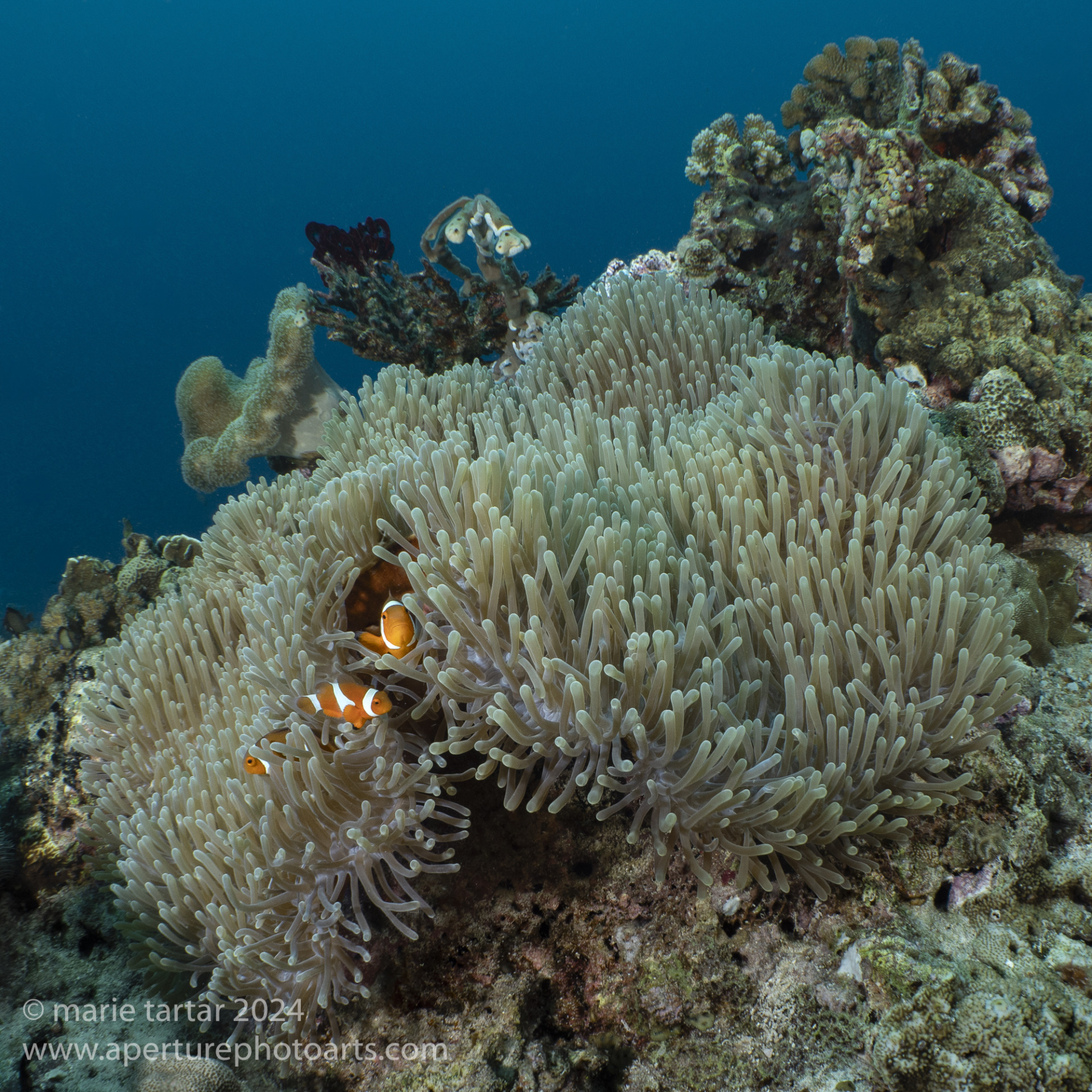

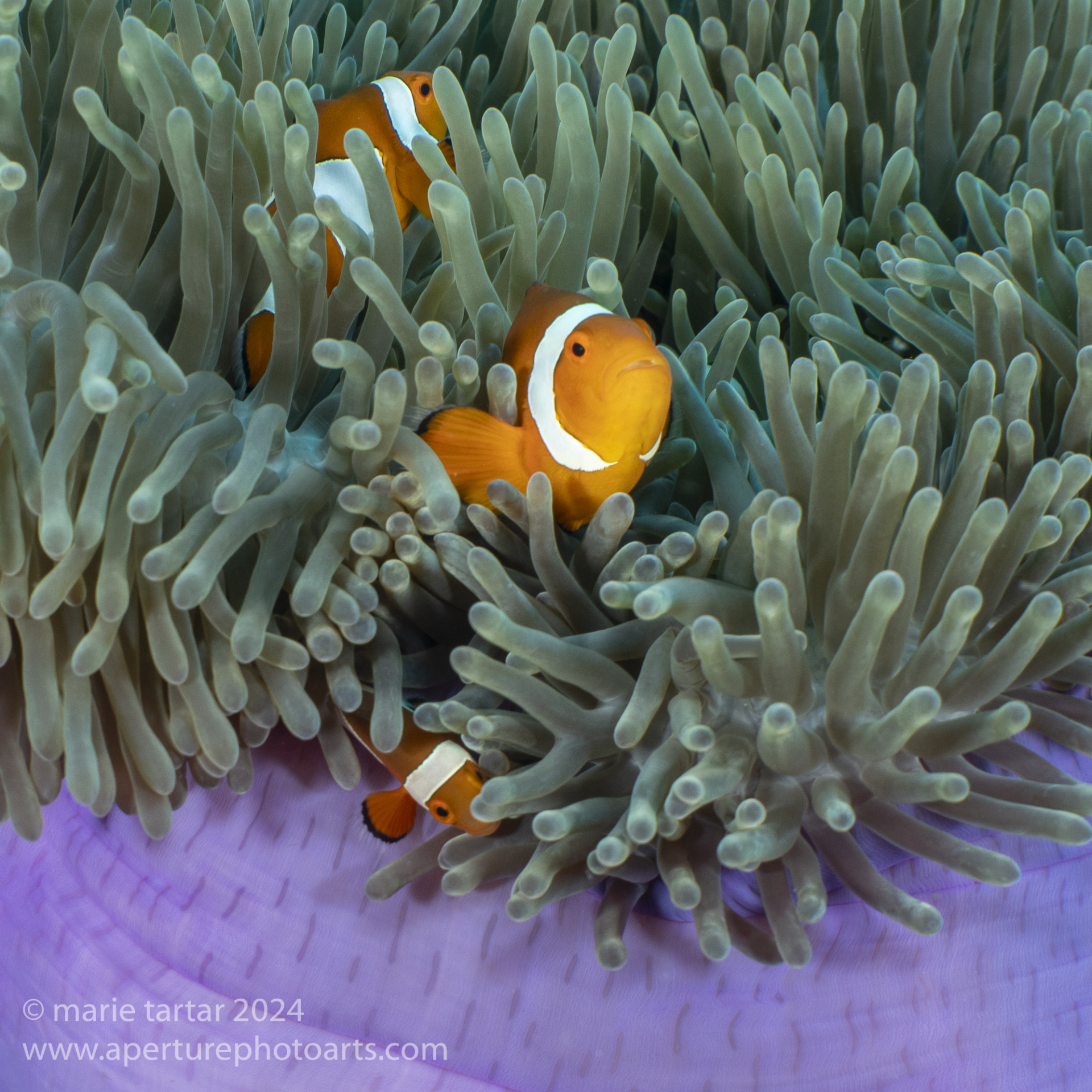

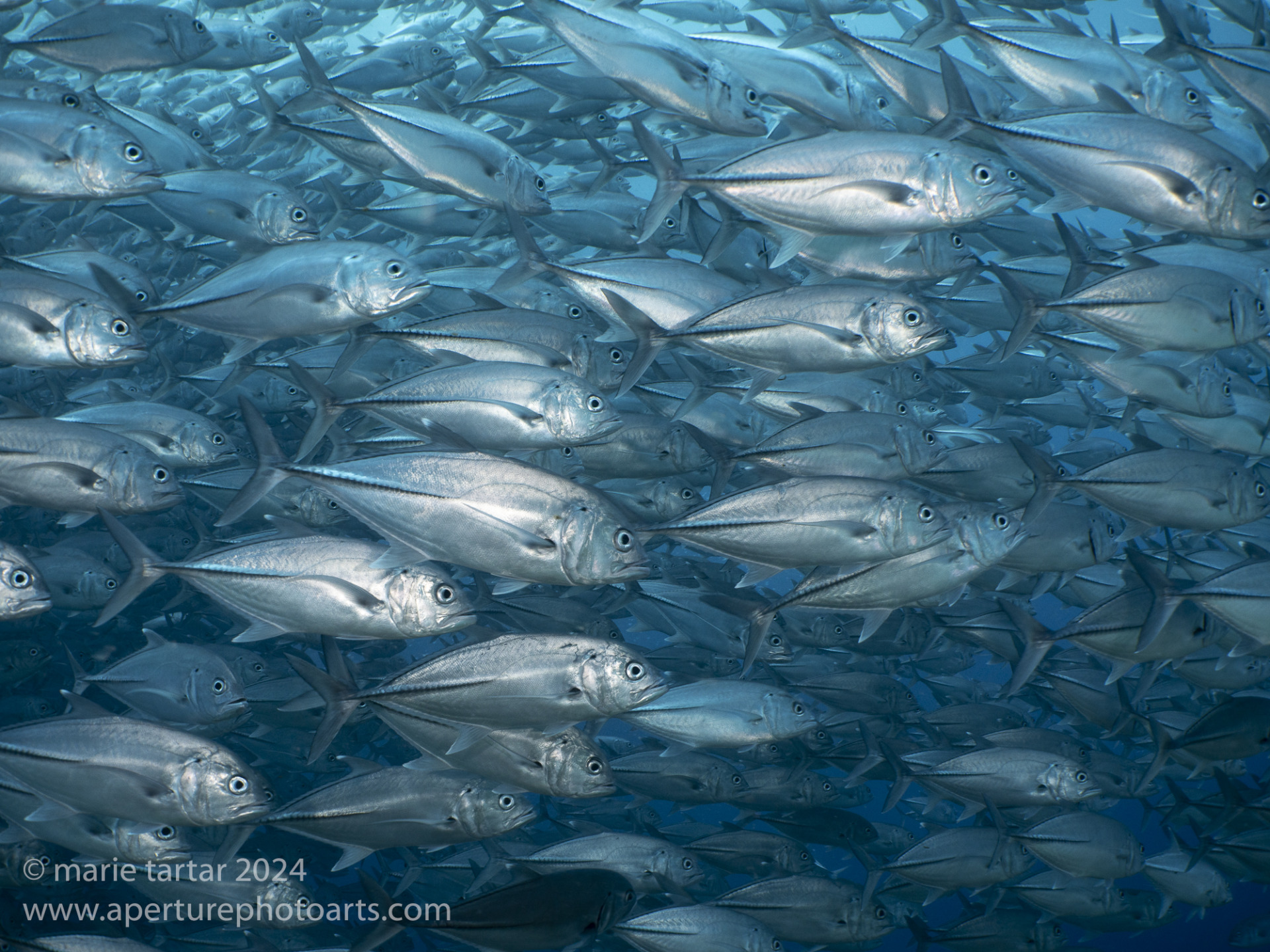
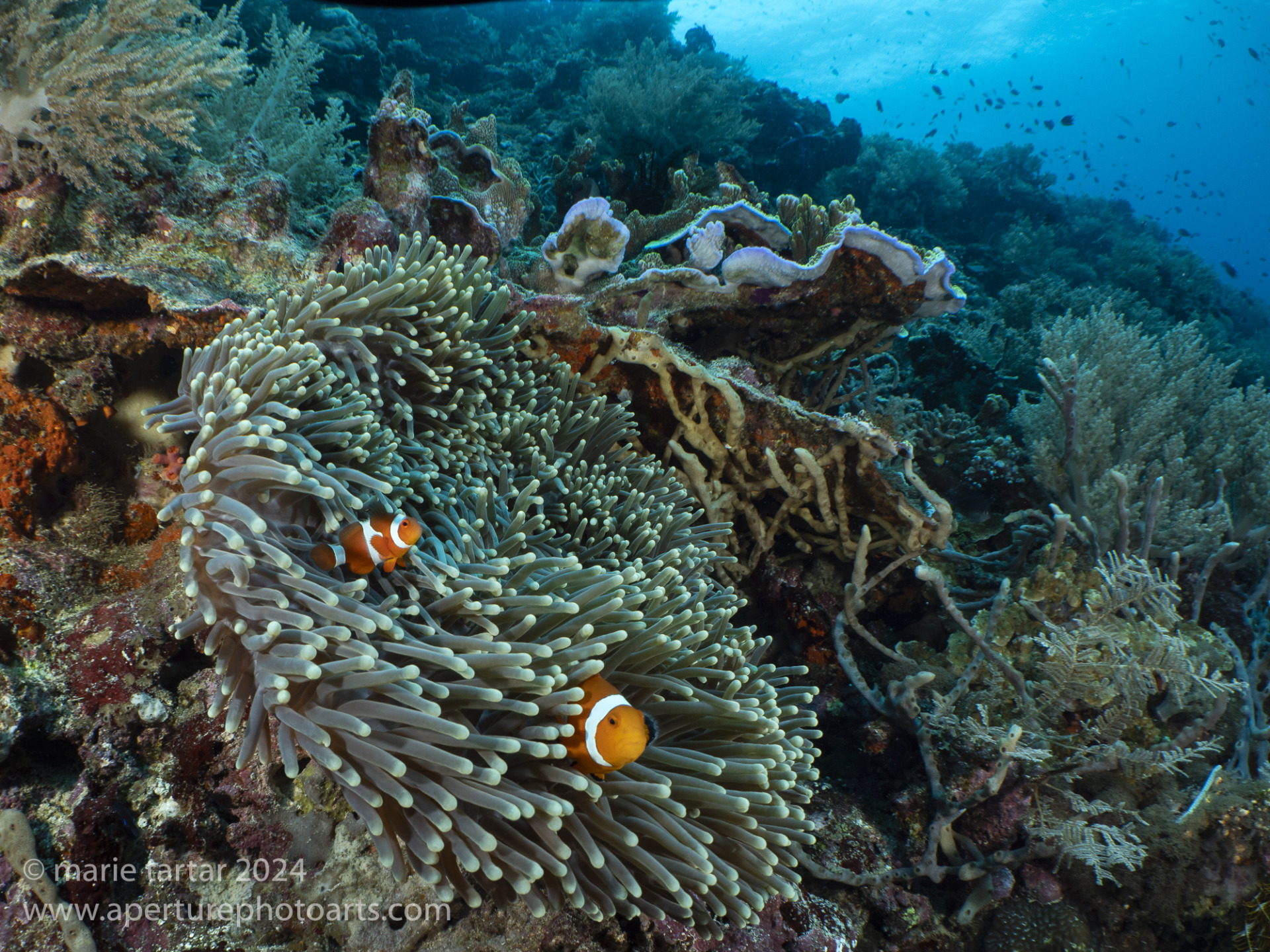
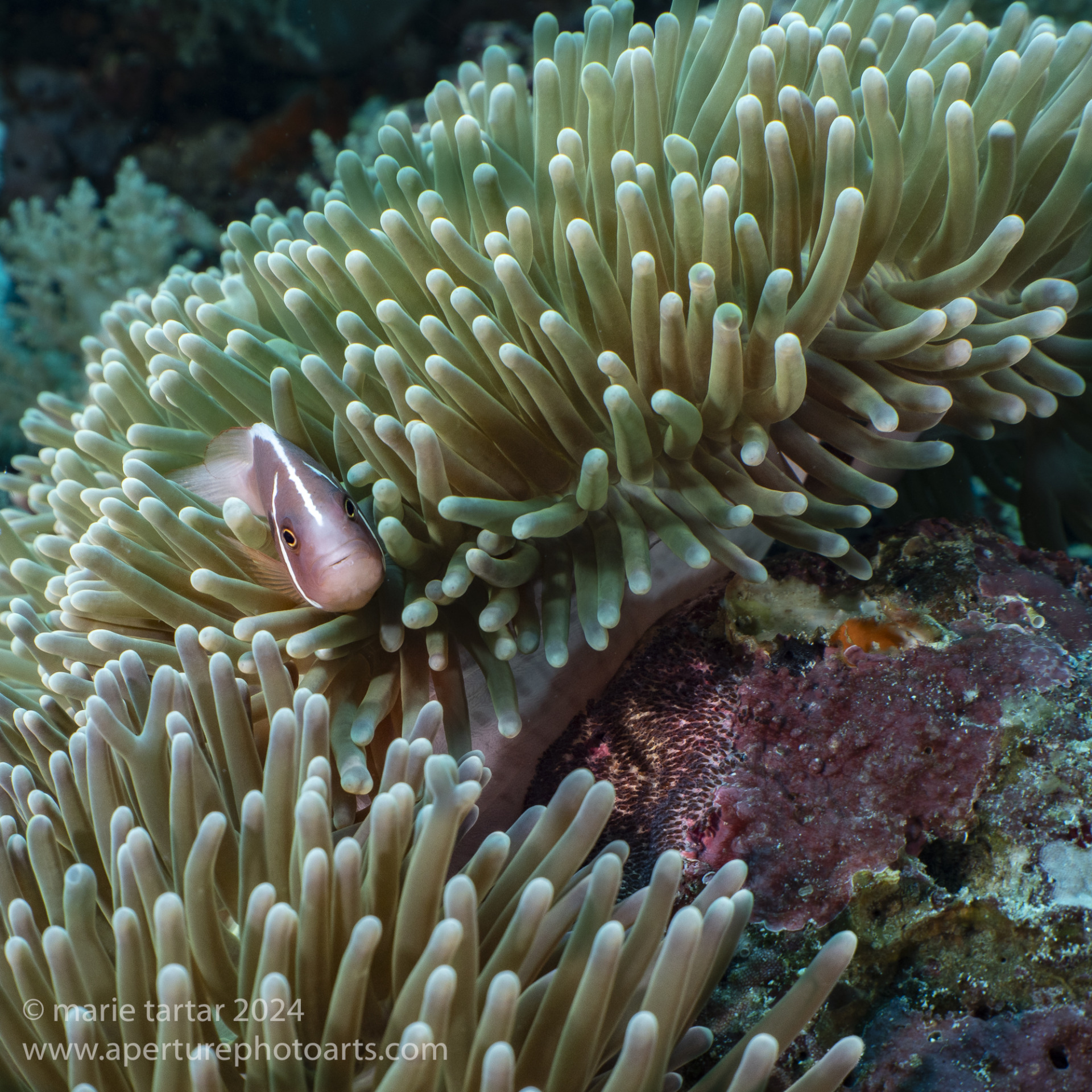
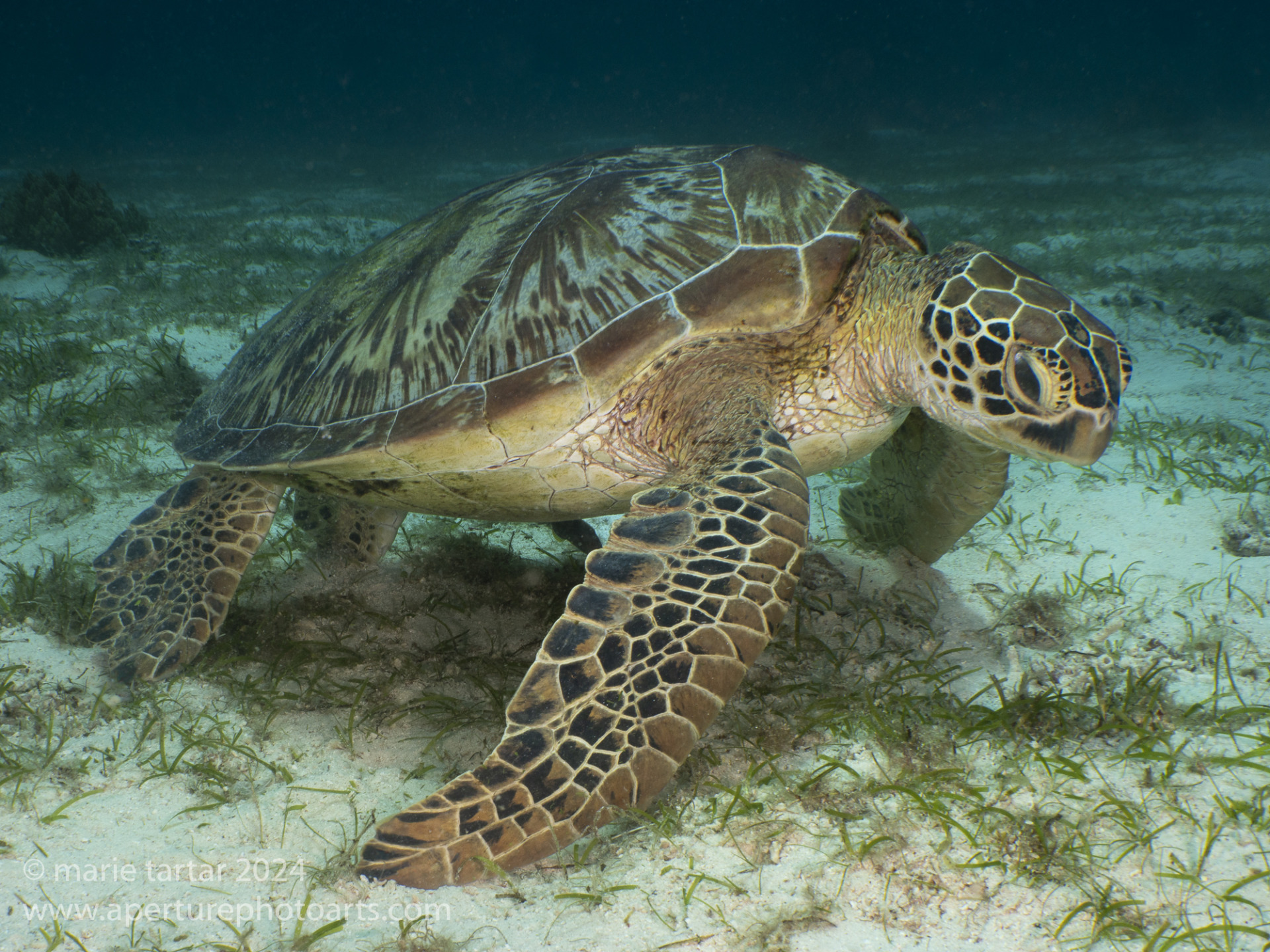
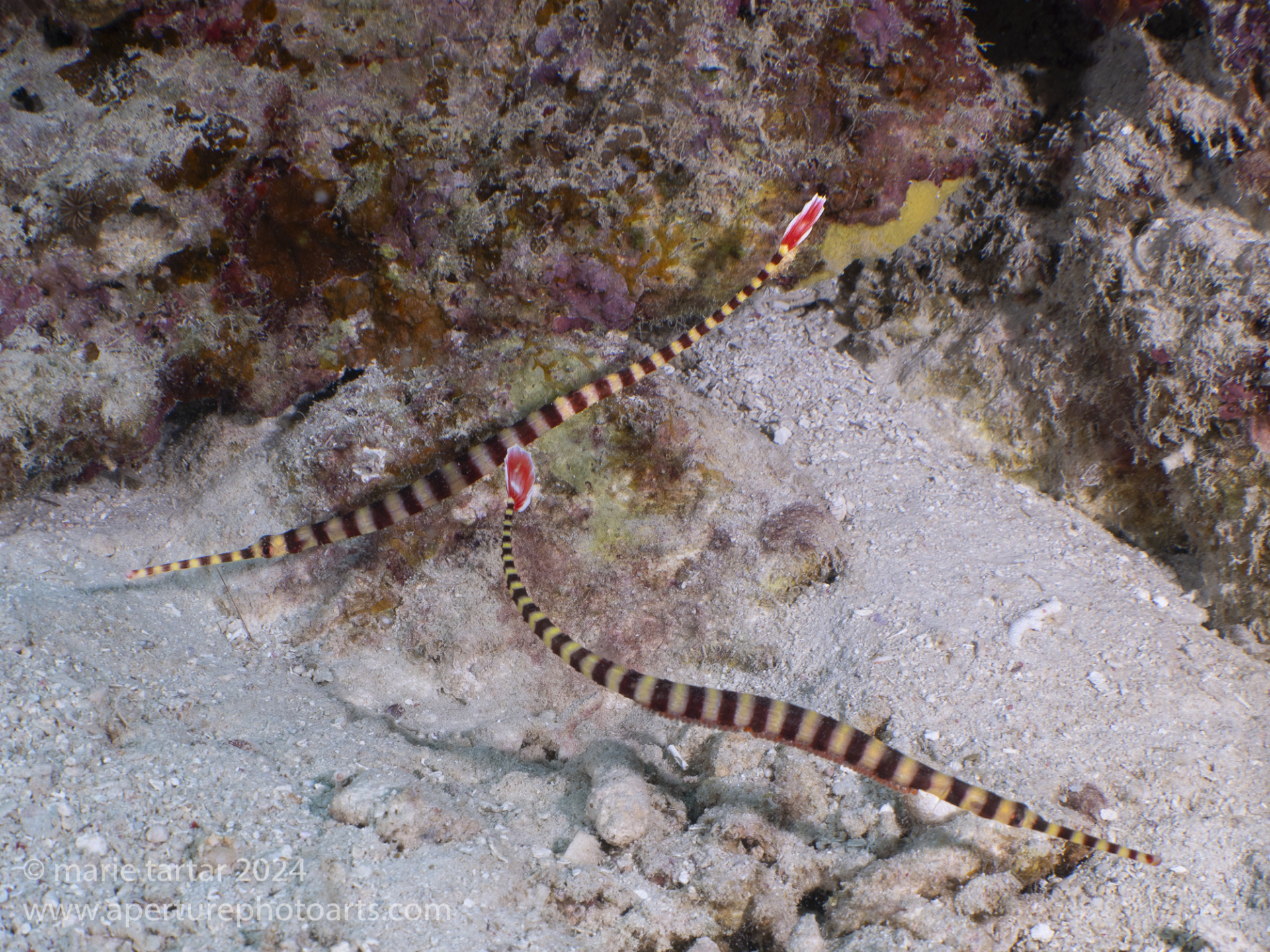
Absolutely amazing photos, story, and travels! Wow! Thanks for bringing the gorgeous underwater world to us with your photos and blog! Happy 35th Anniversary!!! 💌